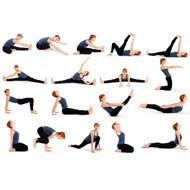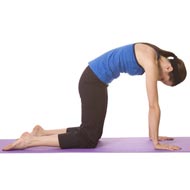- Raja yoga
- Yoga Stretches
- Jivamukti Yoga Poses
- Yoga Tree Pose
- Sun and Moon Yoga
- Wind Removing Pose
- Hare Pose
- Accomplished Pose
- Urdhva Mukha Pinch Mayurasana
- Revolved Abdomen Pose
- Raised Foot Pose
- Scorpion Pose
- Butterfly Pose
- Half Tortoise Pose
- Revolved Twist
- Balancing Stick Pose
- Cat Pose
- Supported Shoulderstand
- Crane Pose
- Handstand
- Happy Baby Pose
- Firefly Pose
- Scale Pose
- Side Plank Pose
- Upward Facing Two-Foot Staff Pose
- Reclining Big Toe Pose
- Stick Pose
- Revolved Head-to-Knee Pose
- Full Boat Pose
- Upward Extended Feet Pose
- Yoga arm balance poses
- Core Yoga
- Inversion Yoga Poses
- Seated And Twist Yoga
- Horse Pose
- Cobbler Pose
- Seated Wide Angle Pose
- The Compass Pose
- Half Crow Pose
- Bound Half Moon Pose
- Lotus Pose
- Reverse Warrior Pose
- Fixed Firm Pose
- Back-bend Poses
- Forward bend Poses
- Sarvangasana
- Ashtanga Yoga Poses
- Warm up poses
- Seated Poses
- Seated Forward Bends
- Chair Poses
- Standing Poses
- Standing Balancing poses
- Yoga Asanas
- Hatha Yoga Asanas
- Yoga Postures Online
- Partner Yoga Poses
- Anusara Yoga Poses
- Advanced Yoga poses
- Restorative Yoga Poses
- Kids Yoga Poses
- Beginning Yoga Postures
Yoga Poses & Exercises
Yoga is a very old Indian practice that goes back to over 5000 years. The term ‘yoga’ comes from a Sanskrit word ‘yuj’, which actually means to bring oneself to a disciplined way of life.
There are many types of yoga but Raja and Hatha yoga are most popular in the West.
It is believed by ancient yogis that for man to harmonize with the environment and himself, he has to unite the spirit, mind and body, and for all of it to be united, there must be balance in the physical, emotional and spiritual aspect of life. The way to maintain and achieve this balance is through meditation, breathing, and yoga postures. Thus, both the body and the mind are used when practicing yoga exercises, as it requires perseverance and willpower to be able to perform each of the yoga asanas. Regular practice of the yoga positions can result in plenty of benefits, including stimulation of the internal organs and improving blood circulation. Yoga stretches provide benefits to the mind and body and bring about balanced energy flow. This is especially helpful for women who are in the menopause transition or currently in menopause.
Types
The different types of yoga poses serve various purposes and include levels of difficulty in different ranges. Some of the yoga poses provide more benefits than others.
- Arm balance Poses: Arm balance poses help strengthen the core and arms. These poses will involve either supporting your whole body with your arms or just your upper body. Some of the arm balance poses include Dandasana(Plank Pose), Chaturanga Dandasana or the Four-Limbed staff Pose, Vasisthasana (Side Plank Pose), Bakasana (Crane Pose), Astavakrasana (Eight Crooked Limb Pose), and Pincha Mayurasana (Feathered Peacock Pose).
- Backbend Poses: There are many ways in which the backbend poses can be practiced. Poses like Dhanurasana (Bow Pose) begin with the student on the stomach and builds back flexibility and leg strength. Students perform Natarajasana (Lord of the Dance Pose) from a standing position to improve balance as well as flexibility. Some other backbends include Setu Bandha Sarvangasana (Bridge Pose), Bhujangasana (Cobra Pose), Ardha Bhekasana (Half Frog Pose), Kapotasana translated into the King Pigeon Pose and Urdhva Dhanurasana (Upward Bow or Wheel Pose).
- Bandha Poses: While there are many yoga bandha poses, the most common ones are Jalandhara Bandha (Net-Bearer Bond), Uddiyana Bandha (Upward Abdominal Lock), and Mula Bandha (Root Bond). Each bandha is considered a lock, which closes a certain part inside the body. These locks are made use of in various asanas and pranayamas to energize, cleanse and stimulate the organs. When all the three locks or the three bhandas are simultaneously activated, it is known as the great lock or maha bandha.
- Core Poses: Core poses are yoga poses that strengthen your abs and core. Some of the core poses include Marjaryasana (Cat Pose), Bakasana (Crane Pose), Ananda Balasana (Happy Baby Pose), Bhujapidasana (Shoulder-Pressing Pose), Anantasana (Side-Reclining Leg Lift) and Paripurna Navasana (Full Boat Pose).
- Forward Bend Poses: Forward bend poses help strengthen the organs of the abdomen and stretch the hamstrings and back muscles. Some of the forward bend poses include Adho Mukha Svanasana (Downward Facing Dog), Uttana Shishosana (Extended Puppy Pose), Parsvottonasana (Intense Side Stretch Pose) Marichyasana I (Pose Dedicated to the Sage Marichi, I), Ardha Uttanasana (Standing Half Forward Bend) and Prasarita Padottanasana (Wide-Legged Forward Bend).
- Inversion Poses: Inversions are known to be effective in cleaning the circulatory system, stimulating the glands, and reducing fatigue. In a full inversion, you will need to bring your feet over your head like in Sirsasana (Headstand) and Sarvangasana (Shoulder stand). These inversions help build core strength and endurance. Yoga poses like Uttanasana (Standing Forward Fold) and Setu Bandha Sarvangasana (Bridge Pose) are half inversions.
- Meditation Poses: Using meditation poses for meditation is considered to be better than lying down. This is because it reduces the chances of you going to sleep. Some of the meditation poses include Padmasana (Full Lotus Posture), Ardha Padmasana (Half Lotus Pose), Egyptian Pose, and Burmese Pose.
- Pranayama Poses: Pranayamas are effective in bringing about good health through the process of breathing. The pranayama exercises improve breathing technique from rapid and shallow breathing to a healthy duration of breathing. Some of the good pranayama poses you can practice the breathing exercises on are Sukhasana (Easy Pose), Ardha Padmasana (Half-Lotus Pose) and Padmasana (Lotus Pose).
- Restorative Poses: The aim of the restorative poses is to bring about relaxation. Some of the restorative poses are Balasana (Child’s Pose), Viparita Karani (Legs-Up-the-Wall Pose), and Savasana (Corpse Pose).
- Seated & Twist Poses: Seated and twist poses are effective in increasing the flexibility of the spine. Deep twists are also known for their detoxifying and cleansing benefits. Some of the seated and twist poses are Bharadvajasana I (Bharadvaja's Twist), Gomukhasana (Cow Face Pose) and Agnistambhasana (Fire Log Pose).
- Standing Poses: Standing poses help increase flexibility and strength. They can also increase your awareness of body posture and energize your body. Some of the standing poses include Tadasana (Mountain Pose), Trikonasana (Triangle Pose) and Uttanasana (Standing Forward Bend).
What are the seated yoga poses?
Seated poses can be extremely basic and extremely advanced as well. The easy pose as the name suggests is an example of yoga seated pose that is easy to achieve. Beginner seated yoga poses are used to improve posture and to encourage students to focus on breathing exercises. The collection of yoga seated poses marichyasana 1, 2 and 3 are variations of one of the advanced poses of yoga that involves a seating pose. This pose should only be attempted by someone who has a fair degree of flexibility as well as a good amount of control over his or her movements.
What is benefits of Sarvangasana?
Sarvangasana (Shoulder Stand) is sometimes called the queen of poses and provides benefits to the mind, body and soul. The literal meaning of Sarvangasana is a 'posture for all body parts'. The working of these inverted postures is by causing the effects of gravity to become reversed on certain parts of the body. The benefits of Sarvangasana include improving the circulation of blood and improving the efficiency of the thyroid, heart, and lungs. Practicing Sarvangasana for weight loss can be effective as it helps in regulating the thyroid gland, which if defective, can bring about weight problems. However, women who are menstruating should avoid practicing this posture.
Why do I need to do a warm up before starting yoga?
Before starting your yoga routine or any exercise for that matter, it is important that you first perform some warm up exercises to loosen the muscles. Performing a warm up before your session will prepare you physically for the yoga poses you will need to perform. If you start directly with the exercise there is a possibility of incurring some injury. There are many warm up poses you can find on the Internet that can help loosen stiff muscles and reduce the chances of injury. For beginners, yoga poses that are taken should be easy to perform and not too strenuous. Following some yoga tips can help you get the most out of your session.
Which Yoga Asana will help for premature ejaculation?
Practicing yoga can be an effective method you can make use of to help with premature ejaculation. Some of the postures of yoga for premature ejaculation are Dhanurasana (Bow Pose), Halasana (Plow Pose), Mayurasana (Peacock Pose), and Bhujangasana (Cobra Pose). These postures also help in dealing with stress and anxiety, which are among the main contributors to premature ejaculation. Practicing yoga for diabetes can help reduce blood pressure and blood sugar levels. Some of the effective yoga asanasfor diabetes are Adho Mukha Svanasana (Downward Facing Dog), Trikonasana (Triangle Pose), and Matsyasana (Fish Pose). It is also important that you combine these postures with a proper diet.
What are the most advanced yoga poses and sequences?
There are many postures in yoga, and although all of them are beneficial, some are more challenging than others. There are some easy poses that can be practiced by beginners, and there are advanced yoga poses that should be done by practitioners with enough experience. Before coming to the advanced yoga postures, it is important that you first perfect the beginner poses. Some of the most advanced yoga poses include Bakasana (Crow Pose), Garudasana (Eagle Pose), and Tittibhasana (Firefly Pose). It is recommended that you perform the advanced yoga sequence first in front of an instructor to get the proper technique.



